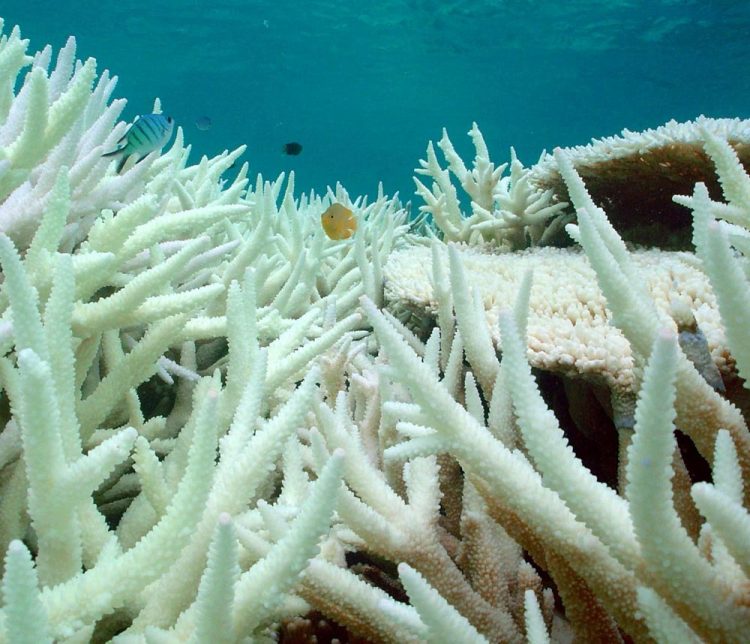Reefs that experience frequent temperature changes most likely to resist coral bleaching

Bleached white corals Credit: Paul Marshall Usage Restrictions: Use in relation to this story only
As scientists and conservationists race to work out the best way to conserve the world's coral reefs, a new study reveals why some reefs appear to be more resistant to coral bleaching during ocean warming events and calls for higher-resolution data to be collected.
The authors, from a number of American Universities and Bangor University in the UK, writing in Nature Communications (doi: 10.1038/s41467-018-04074-2) utilise data collected from 118 coral reef locations globally. They illustrate how reefs over very small distances – as little as tens or hundreds of meters of each other, can be subject to different daily sea temperature changes – based on their depth and their position on the reef.
These reefs end up having different fates during ocean warming events. Reefs subjected to high sea temperature fluctuations on daily or tidal timescales leading up to the ocean warming event are better able to resist coral bleaching, such that a 1oC increase in daily temperature range reduces the odds of more severe bleaching by a factor of 33.
In the short term, this information helps to explain the patchy distribution of coral bleaching across reefs during thermal stress events. In the long term, the information helps to identify reefs that may have a greater potential for resisting thermal stress, information that can help guide marine spatial planning and conservation targets and priorities.
“Rising ocean temperatures and ocean warming events driven by global climate change represent the greatest current threat to the integrity of coral reef ecosystems worldwide” says co-author Gareth Williams of Bangor University's School of Ocean Sciences.
“These warming events have become more frequent and are projected to keep increasing in frequency in the coming decades” says Williams.
Coral reefs represent one of the most diverse ecosystems on our planet, providing essential ecosystem services, like fisheries and shoreline protection, to millions of people.
“It is vital we identify the mechanisms behind the apparent resistance to bleaching on some reefs” says Williams.
“Importantly, our results show that the resistance of corals to bleaching in areas of high-frequency temperature variability occurs in reef regions throughout the world. This positive news should not distract from the urgent need to reduce greenhouse gas emissions to protect coral reefs globally, but instead help guide strategic management actions in the inevitable interim.”
###
High frequency temperature variability reduces the risk of coral bleaching
Authors: Aryan Safaie & Kristen A. Davis, University of California, Irvine; Nyssa J. Silbiger, California State University; Timothy R. McClanahan, University of California, Irvine, & Wildlife Conservation Society; Geno Pawlak, University of California San Diego; Daniel J. Barshis, Old Dominion University; James L. Hench, Duke University; Justin S. Rogers, Stanford University, Gareth J. Williams, Bangor University, UK.
Media Contact
More Information:
http://dx.doi.org/10.1038/s41467-018-04074-2All latest news from the category: Life Sciences and Chemistry
Articles and reports from the Life Sciences and chemistry area deal with applied and basic research into modern biology, chemistry and human medicine.
Valuable information can be found on a range of life sciences fields including bacteriology, biochemistry, bionics, bioinformatics, biophysics, biotechnology, genetics, geobotany, human biology, marine biology, microbiology, molecular biology, cellular biology, zoology, bioinorganic chemistry, microchemistry and environmental chemistry.
Newest articles

Pinpointing hydrogen isotopes in titanium hydride nanofilms
Although it is the smallest and lightest atom, hydrogen can have a big impact by infiltrating other materials and affecting their properties, such as superconductivity and metal-insulator-transitions. Now, researchers from…

A new way of entangling light and sound
For a wide variety of emerging quantum technologies, such as secure quantum communications and quantum computing, quantum entanglement is a prerequisite. Scientists at the Max-Planck-Institute for the Science of Light…

Telescope for NASA’s Roman Mission complete, delivered to Goddard
NASA’s Nancy Grace Roman Space Telescope is one giant step closer to unlocking the mysteries of the universe. The mission has now received its final major delivery: the Optical Telescope…



